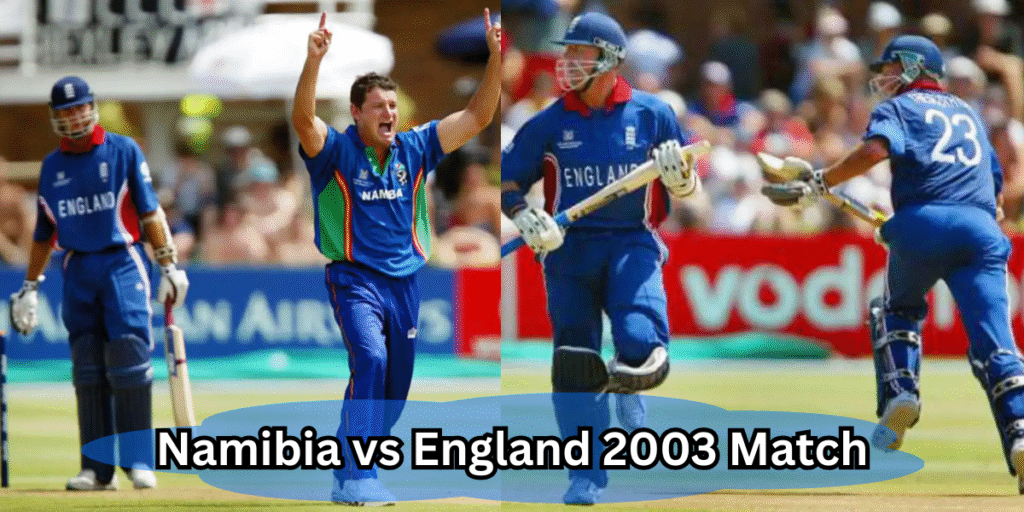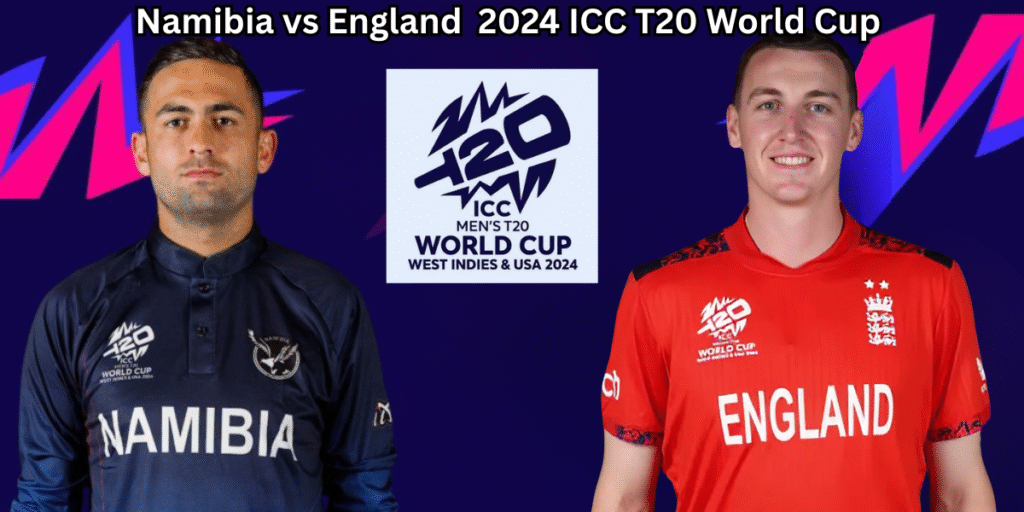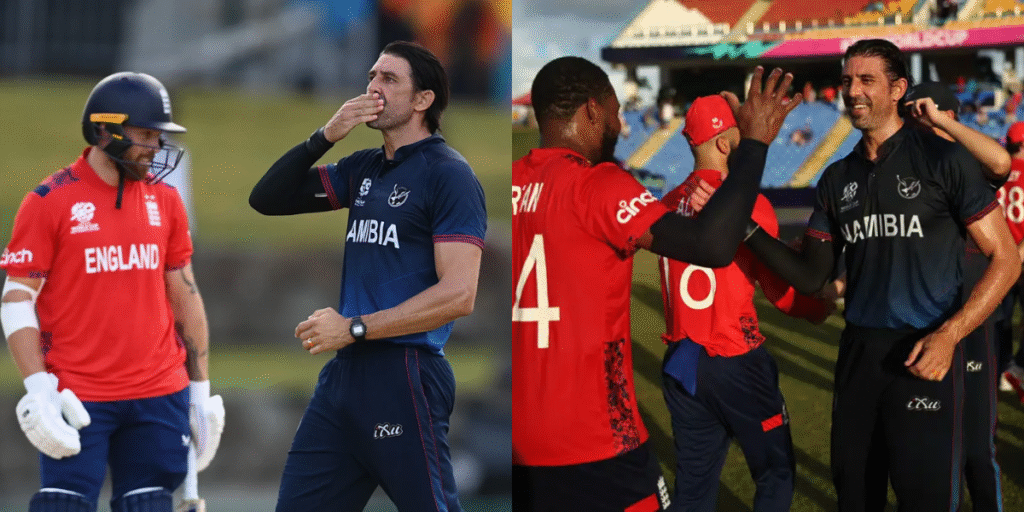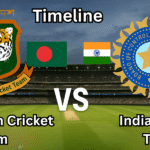Namibia National Cricket Team vs England Cricket Team Timeline: The cricketing backgrounds of England and Namibia don’t intersect in many ways. Where they do intersect, they have made for interesting stories of contrast and development. The two matches played between them over a span of more than twenty years are the 2003 ICC Cricket World Cup match and the 2024 ICC T20 World Cup match. Both matches are astonishingly representative of the evolution of international cricket and the development of teams such as Namibia. While England has won both matches, Namibia’s efforts demonstrated determination, ability, and even progress.
The 2003 Match: A Baptism of Fire

Namibia’s first game on the international cricket stage came in the 2003 ICC Cricket World Cup. Namibia played England on February 19th, 2003, at St George’s Park in Port Elizabeth. Their match was a One Day International of remarkable importance. Not only was it Namibia’s first match against a senior team, but it was a watershed moment in Namibian cricket history.
Namibia called the toss and chose to field. England resulted in a total of 272 runs within 50 overs. Their innings was executed by steady collective performances whereas the individual performances were not dominant. Alec Stewart scored a measured 60 from 77 balls. Marcus Trescothick, often considered dominant and outstanding in how he plays the game, scored an easy 58 runs from 66. All of the middle order players contributed, including Paul Collingwood, Craig White and Andrew Flintoff, and their innings continued the pace, which ended up adding to 270+ score.
Namibia were inexperienced and at times tantalizingly brilliant, and seemingly had the bowling ball in hand for 1 of the most famous spells of the tournament from Rudolph van Vuuren who finished with 5 for 43. Gerrie Snyman kept his country attached with three wickets and gave the Namibian team some genuine hope and respect.
When Namibia batted, they performed emotionally well. Andries Burger will never forget his innings of 85 from 86 balls showing class and aggression. He included some support from his batting partner Danie Keulder who scored 46, and on the scorecard was helped by Bryan Murgatroyd who scored 24 which pushed the innings along. Namibia which batted all their allotment of 50 overs finished with a score of 217 runs at the cost of 9 wickets – they lost by 55 runs.
Although the match was a loss, it was a proud moment for Namibia. Burger’s batting and van Vuuren’s bowling performance garnered recognition in the global cricketing fraternity – they had indicated that newcomers could challenge the strength of established teams. It was not a lost match – it was a message.
The Rematch – 2024 ICC T20 World Cup

Over two decades later, they faced England again, but this time in a different format, at the Sir Vivian Richards Stadium in North Sound, Antigua on June 15, 2024, during the 2024 ICC T20 World Cup. There was obviously a lot of change in the game and team since then.
The game has been reduced to 10-overs a side because of horrible weather conditions, so we had a sprint rather than a marathon or 20 overs. England batted first, putting 122 for 5 in their innings, with Harry Brook hitting a crucial 47 not out from 20 balls, striking the ball aggressively but in an elegant style. Jonny Bairstow scored 31 from 18 and Moeen Ali made a swift 16 from 6 balls.
Namibia’s bowlers struggled with this format of the game and the run-rate, although there were some slightly better periods. Ruben Trumpelmann took two wickets for his work and went at a relatively decent run-rate and David Wiese held up reasonably, bowling at a good economy rate showing experience and temperament under pressure.
Namibia started well in chasing down a DLS-adjusted target of 126, with opening batsman Michael van Lingen anchoring the innings superbly with 33 runs from 29 balls while David Wiese chipped in with a mere 27 runs from 12 balls. The English bowling was calm and consistent – Reece Topley took 2 extreme overs for only six runs; Jofra Archer bowled well and took a wicket (though not at Topley’s speed) and Namibia finished on 84 for 3, 41 runs short of the DLS target.
The match didn’t just provide evidence of England consistency in white-ball cricket, it also provided evidence of Namibia’s development as a more competitive side in the shorter format of the game. Namibian tourists were the victors on this occasion, but you could see and appreciate the fight and potential of their tour from the outset.
The Journey Between Two Worlds
Across the two matches, the story of England vs Namibia has changed from one of a giant and an underdog to a more nuanced battle between an established power and a rapidly emerging contender. The Namibians were inexperienced and playing against established professionals in 2003; they had little other than spirit and raw passion, but they were able to leave an impression. By 2024, the Namibians have graduated into a team that can genuinely challenge top teams in high-pressure, fast-paced T20 matches.
The human stories – Burger’s lovely 85, van Vuuren’s five wickets, Wiese’s power-hitting finish, or Brook absorbing anything that was thrown at him – are each examples of the evolving narrative. The England team has witnessed the evolution in names, terminologies and styles of teams often associated with success. The transition from the judicious ODI outfit of 2003 to top-class T20 outfits in 2024 has been reflective of the journey cricket has undertaken in the minds of the English sporting public.
A little peek into the future

England have never lost to Namibia in their previous encounters, but the margins are narrowing, just! Namida have become a vast, phased-out cricketing nation since 2003. The developments and growing structure of their cricketing framework, player pathways and international opportunities for players is impressive. Both forms of the game (50 overs and T20) both punctuated by a team that is clearly still no longer just going to participate, but to actually compete.
The journey between England and Namibia is ultimately one of growth, and how such countries can fit into future of cricket. It’s about a positive transition to inclusion and competitive growth, making space for greater representation from outside of the established fostering cricketing nations. Namibia moves forward on the periphery, and we can only ponder how long it will be until they generate results against teams that resemble England.
In the shifting sands of international cricket, England v Namibia will stand as reference points, reminding us that while dominance is earned, it is never permanent. And that in this game, one can find comfort in its unpredictability and ability to thrill and its ever-changing future.
Read Also
- India National Cricket Team Vs South Africa National Cricket Team Timeline
- Australia Women’s National Cricket Team vs India Women’s National Cricket Team Timeline
- Bangladesh National Cricket Team Vs New Zealand National Cricket Team Timeline
- Afghanistan National Cricket Team vs India National Cricket Team Timeline
- South Africa National Cricket Team Vs Bangladesh National Cricket Team Timeline
- Scotland National Cricket Team Vs England Cricket Team Timeline
- Sri Lanka National Cricket Team vs New Zealand National Cricket Team Timeline



